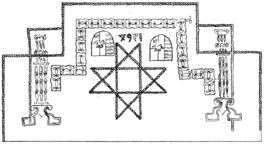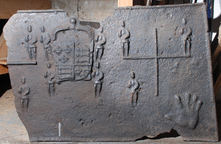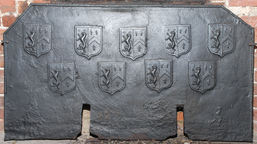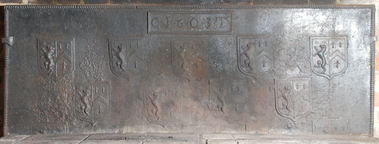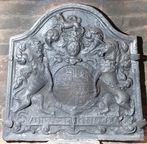-
839
Description: Fragment (left quarter missing - symmetrical design assumed); rectangular; twisted rope edging (top and sides); top centre, crowned Tudor shield between two lions passant, the left lion guardant sinister; below each lion, two leftward heading ‘imp’ stamps, the left one of each with arms down and head facing right, the right with right arm raised; in the top corner(s), a crowned rose stamp with a ‘daisy’ stamp towards the middle.
Notes: Assuming the crowned shield is central, the fireback would have originally measured 1160mm wide; one of the ‘Royal’ series.
Arms: Tudor royal arms of England
- Decoration tags:
- rectangular (shape)
- rope (edging)
- carved stamps
- heraldic
- armorial
- animals
- plants
Manufactured: in the mid-16th century in the Weald area of England.
Current location: in private hands Battle, East Sussex, England.
- Attached to series:
- Royal series
-
644
Description: Formerly arched rectangular, arch now missing; cavetto-moulded edging, invected on the inner edge; English royal Stuart shield, garter, crown (mainly missing), supporters and motto; date split either side of crown; monogram to right of unicorn supporter.
Notes: The monogram probably identifies the pattern-maker, whose invected edging seems to be a distinctive style. From another fireback of the same design (no. 1018), complete with the arch, the height is approx 710mm.
Inscription: 1638 / HONI SOIT QUI MAL Y PENSE / RN / DIEV ET MON DROIT
Arms: English Stuart royal
- Decoration tags:
- rectangular (shape)
- invested cavetto (edging)
- whole carved pattern
- individual numbers
- monogram
- armorial
- royal
- text
Manufactured: in 1638 in England.
Current location: Six Poor Travellers House, High Street, Rochester, Kent, England.
Museum number: A4328 (part of the Rochester Guildhall Museum museum group)
- Attached to series:
- RN series
- Carolean royal armorial firebacks
- Stuart royal armorial firebacks
-
1015
Description: Rectangular with two-stepped top; twisted rope edging (top and sides); twisted rope extensions enclosing intermediate step with rope continued parallel to sides; central rope octagram with reversed date above between repeated inverted shield shapes off-set (left higher than right); the shield blazon: barry wavy impaling quarterly, overlaid with a small bird stamp and an indistinct ?bird shape in the top left quarter as viewed; within the rope, a roughly parallel arrangement of 23 double-loop-patterned stamps, with the faint impression of an additional stamp in the top right corner of the arrangement; outside the loop stamps and partially overlying the vertical rope extensions, the impressions of two classically designed firedogs with Ionic capitals and fluted pilasters, bearing the date 1594, but with the '1' missing; the fluting on the pilasters has been overlaid by the repeated impression of a turned peg.
Notes: A large and remarkably elaborate fireback: the octagram, a device seen as uncommonly on continental firebacks as on English ones, suggests an apotropaic purpose; the impression of the firedogs was clearly made after the laying of the rope lengths and impressed less deeply as the rope impression has not been obliterated by the firedog on the left side. A fireback with the same loop stamps bears the same date using the same numerals but impressed the correct way round. Currently obscured behind a wood stove.
Inscription: 4951 [5 reversed] / 594 594
- Decoration tags:
- stepped (shape)
- rope (edging)
- simple stamps
- carved stamps
- individual numbers
- apotropaic
- armorial
- text
- objects
Manufactured: in 1594 in the Weald area of England.
Current location: Fyning Manor, Rogate, West Sussex, England.
-
659
Description: Rectangular with complex quasi-arched rectangular top; ovolo moulded edging; shield with Royal arms of France in a cartouche; above, an English crown.
Notes: A different version of no. 488. The combination of the English crown and French arms is common and may relate to the marriage of Charles I and Princess Henrietta Maria of France in 1625; probably the work of the same pattern maker. Many copies exist of this fireback.
Copies of this fireback are known.
Arms: French royal
- Decoration tags:
- rectangular with round arch (shape)
- ovolo (edging)
- whole carved pattern
- armorial
- royal
Manufactured: in the early- to mid-17th century in the Weald area of England.
Current location: in private hands, Rolvenden, Kent, England.
- Attached to series:
- Ornate border series
- Miscellaneous royal firebacks
- Anglo-French armorial firebacks
-
661
Description: Fragment; quasi-rectangular; twisted rope edging (top and sides), cavetto edging at bottom; originally, probably a symmetrical arrangement comprising a central, crude crowned, Tudor royal shield, with a standing human figure, its right arm bent at the elbow and its left arm crossing its waist, repeated in upper and lower positions on each side of the shield; to left and right, a twisted rope length repeated in the form of a cross, with the human figure placed above each transverse end and another below the cross and towards the shield; in the bottom corner(s), a (left) hand print.
Notes: The same crowned shield and use of hand print can be seen on a fireback at Etchingham (no. 60), indicating a common source.
Arms: Tudor royal
- Decoration tags:
- rectangular (shape)
- simple stamps
- carved stamps
- armorial
- royal
- humans
- objects
Manufactured: in the early- to mid-16th century in the Weald area.
Current location: Hole Park, Rolvenden, Kent, England.
-
663
Description: Rectangular, with canted top corners; twisted rope edging (top and sides only); nine shields of Ayloffe impaling Sulyard in two rows, 5-4; two parallel vertical cuts for the insertion of firedogs.
Notes: Ayloffe: sable, a lion rampant Or, collared gules, between three crosses formy of the second; Sulyard: argent, a chevron gules between three pheons inverted sable. William Ayloffe (c1535-1584) of Bretons, Hornchurch, Essex, Justice of the Court of Queen’s Bench, married (c1560) Jane, dau. of Sir Eustace Sulyard, of Runwell, Essex. There is a large number of variants using the same shields.
Arms: Ayloffe impaling Sulyard (William Ayloffe of Bretons, Hornchurch)
- Decoration tags:
- rectangular with canted top corners (shape)
- rope (edging)
- carved stamps
- armorial
Manufactured: in the early-17th century in the Weald area of England.
Current location: in private hands, Rolvenden, Kent, England.
- Attached to series:
- Ayloffe series
- Personal armorial firebacks
- Andiron slot firebacks
-
665
Description: Rectangular; twisted rope edging (probably on on top and sides only); cavetto-moulded-edged rectangle top centre, enclosing date between initials; 14 shields of Ayloffe impaling Sulyard in three rows (5-4-5).
Notes: Ayloffe: sable, a lion rampant Or, collared gules, between three crosses formy of the second; Sulyard: argent, a chevron gules between three pheons inverted sable. William Ayloffe (c1535-1584) of Bretons, Hornchurch, Essex, Justice of the Court of Queen’s Bench, married (c1560) Jane, dau. of Sir Eustace Sulyard, of Runwell, Essex. There is a large number of variants using the same shields. The bottom part of the fireback is obscured in the photograph. The initials 'CT' are likely to be those of Charles Tyler, a founder whose working life and that of his family have strong parallels with the occurrence of these firebacks.
Inscription: C.1.6.0.3.T
Arms: Ayloffe impaling Sulyard (William Ayloffe of Bretons, Hornchurch)
- Decoration tags:
- rectangular (shape)
- rope (edging)
- carved stamps
- individual letters
- individual numbers
- armorial
- text
Manufactured: in 1603 possibly at Bedgebury Furnace, Goudhurst in the Weald area of England.
Current location: in private hands, Rolvenden, Kent, England.
Citation: Gardner, J. S., 1898, 'Iron Casting in the Weald', Archaeologia, 56, 1, pp. 133-164.
- Attached to series:
- Ayloffe series
- Personal armorial firebacks
-
666
Description: Inclined rectangle with ogee arch; fillet and ogee moulded edging; garter enclosing English Stuart royal arms, with supporters, helm, crest, mantling and motto.
Notes: Standard armorial design; the inclined shape is uncommon.
Inscription: [Garter motto illegible] DIEV ET MON DROIT
Arms: English Stuart royal
- Decoration tags:
- rectangular with round arch (shape)
- ovolo (edging)
- whole carved pattern
- armorial
- royal
- text
Manufactured: in the 17th century in England.
Current location: in private hands, Rolvenden, Kent, England.
- Attached to series:
- Stuart royal armorial firebacks
-
667
Description: Armorial within complex ovolo moulded edging (top and sides); quartered shield, helm, crest and mantling; plain panel below.
Notes: The arms can be identified from the first four quarters on the memorial to Raffe Maynard, d.1613, in St Albans Cathedral; quarterly, 1, Maynard: argent, a chevron azure between three sinister hands couped at the wrist gules; 2, Filleigh: gules, a fess vairy between six crosses formy or; 3, Harris/Hawes/Hewish: gules fretty argent a canton of the second; 4, Lyons: argent a chevron sable between three lions dormant coward gules; the crest, a stag statant, is of Maynard. The Maynards, originally from Devon, were a large family in Rotherfield, and Richard Maynard (d.1619) had an interest in Old Mill, Mayfield, as well as in Birchden forge, and probably Hamsell furnace. An example without the extension panel at the bottom has been noted. A larger fireback with the same arms, and probably by the same pattern maker, can also be seen (no. 144).
Copies of this fireback are known.
Arms: Maynard
- Decoration tags:
- rectangular with round arch (shape)
- ovolo (edging)
- whole carved pattern
- armorial
Manufactured: in the late-16th century in the Weald area of England.
Current location: Hole Park, Rolvenden, Kent, England.
- Attached to series:
- Personal armorial firebacks
- Ornate border series
- Maynard arms firebacks
-
976
 ? x ? mm
? x ? mmDescription: Plain rectangular plate with detached pediment; central shield with motto scroll below.
Notes: The severe classical form suggests that this back may have been intended for attaching to a grate. Blazon: Tynte - Gules, a lion couchant between six cross-crosslets Argent; Kemeys - Vert, on a chevron Argent three pheons Sable.
Inscription: DYW DY RAS
Arms: Tynte quartering Kemeys
- Decoration tags:
- rectangular with detached pediment (shape)
- none (edging)
- whole carved pattern
- armorial
Manufactured: in the 18th century in Wales.
Current location: Cefnmabli, Rudry, Glamorgan, Wales.
- Attached to series:
- Personal armorial firebacks


